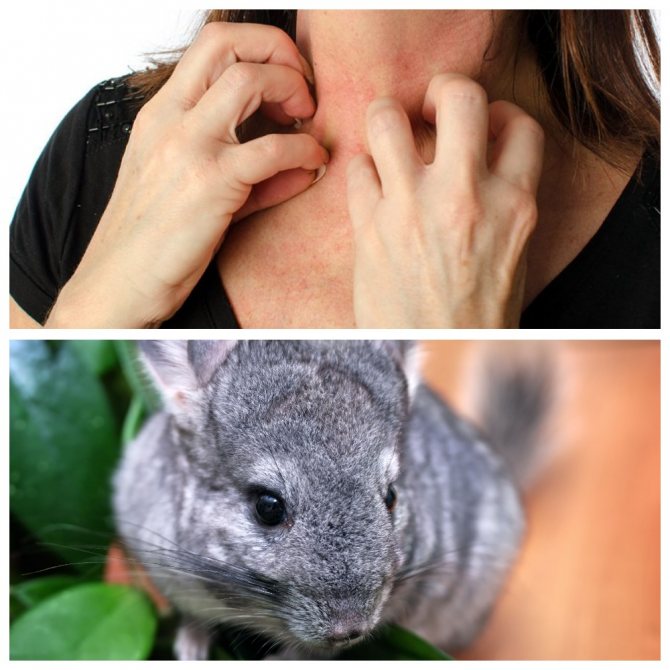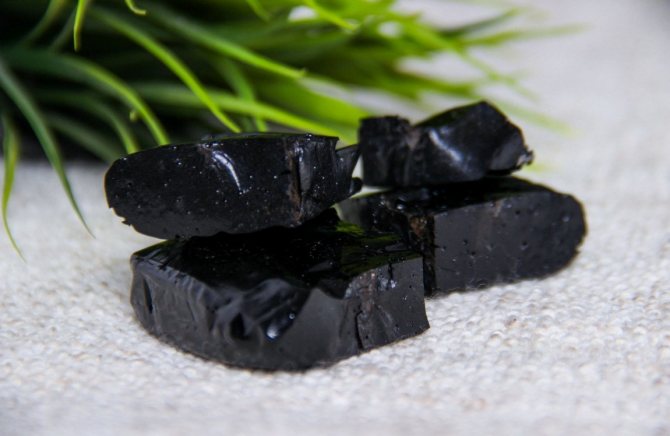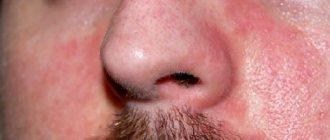Can you be allergic to chinchilla?
Many people ask the question: “Is there an allergy to cute chinchillas?” Yes, sometimes. The fur of other animals, such as cats and dogs, causes the strongest reaction in the body, accompanied by a rash, sneezing and red eyes.
Unlike them, this furry animal does not lick itself and does not leave particles of its saliva on the surface of its body. The allergen in the animal is found in the urine and excrement. When it enters the human body, a specific response occurs. The immune system begins to actively produce antibodies. This is explained by the fact that the protein found in waste products is recognized as foreign and must be disposed of immediately.
Causes
There are many things to consider before getting a chinchilla. This animal lives in a cage, so waste products accumulate in one place. It has no sweat or sebaceous glands, so there is virtually no odor. The fur is dense, so it is uncomfortable for parasites to develop there. The causes of allergies are as follows:
- The urine is absorbed into the sawdust, which dries out. When cleaning the cage, the sawdust is changed, which raises wood dust, with which protein from the urine enters the body and leads to an allergic reaction.
- The epidermis of these animals is separated in the usual way, becomes part of the dust and enters the human body through the respiratory tract.
- The epidermis and urine, excrement fall on the wool, upon interaction with which allergens affect the person.
How does contact with an allergen occur?
The fur of the fluffy animal itself does not cause allergies. A person begins to exhibit specific symptoms when he picks up an animal or removes a cage. When in contact with sawdust, which contains particles of urine and excrement, the immune system is activated in response to the irritant.
Contact with the allergen also occurs when feeding and playing with the chinchilla. The animal's movement is limited to a cage, which does not provoke a sudden exacerbation. Unlike cats and dogs, these cute creatures do not shed, so their fur does not cause any discomfort to the owner. During the daytime they prefer to lead a sedentary lifestyle and love to sleep sweetly.

Useful tips
If an allergic reaction to a chinchilla develops, it is recommended to stop keeping the animal. If your pet has become an integral part of the family, it is recommended to take a number of preventive measures.
- Contact with animals is kept to a minimum.
- Let a person without an allergic reaction clean the cage. If this is not possible, you need to protect yourself with special gloves and a bandage on your face.
- Regularly ventilate the room in which the chinchilla is constantly located. Just remember that rodents are afraid of drafts. You shouldn’t forget about their health.
- Strengthen the immune system with vitamins, proper nutrition, and regular exercise.
- Use a humidifier with an air purification function or simply do not forget about regular wet cleaning.
To reduce the likelihood of developing an allergic reaction, you need to properly care for your chinchilla and its fur.
In natural conditions, animals use sand baths for “bath procedures”. When maintaining a home, it is also necessary to ensure that hygiene procedures can be carried out in this way. Special sand made from raw materials of volcanic origin cleans the fur of parasites, saliva, and traces of urine. Regular brushing of the animal gets rid of dead hairs. This also reduces the amount of epidermis that mixes with dust.
Symptoms
Allergy to chinchilla manifests itself in a variety of symptoms. As a rule, they begin after close contact with the irritant for three hours and pass in a mild form.
- Redness of the eyes and excessive tearing.
- Frequent sneezing and allergic rhinitis (nasal congestion and runny nose).
- General malaise.
- Irritability.
- Drowsiness.
- Headache.
- Skin reactions: redness, itching, local swelling, numerous rashes.
How to recognize your allergies?
In general, allergy symptoms are similar to allergies to other pathogens. You should pay special attention to your condition if you notice itching and characteristic rashes on the skin after contact with your pet. Secondary signs are:
- frequent sneezing,
- eyes begin to water,
- as a “bonus” - a runny nose and redness of the eyes appear.
If the allergy occurs with complications, more serious consequences may occur, such as choking or prolonged coughing. It is worth paying attention to blood pressure: in the case of allergies, arterial blood pressure can be higher than normal. There are also general symptoms of heart failure, cyanosis of the triangle in the nose and lips, as well as various skin problems such as urticaria.
In some severe cases, damage to the nervous system is observed, causing the patient to become irritable and inhibited. Frequent headaches and insomnia occur. Moreover, the general condition of the body can at first be confused with ordinary fatigue or overwork.
The most serious consequences of an allergic reaction are angioedema and anaphylactic shock. Outwardly, this manifests itself as attacks of suffocation, the face swells in an unnatural way, and there is a risk of death from paralysis of the facial muscles. It should be noted that in the case of anaphylactic shock, it develops instantly and in the absence of truly emergency assistance, the condition can critically worsen in the shortest possible time.
Diagnostics
The manifestation of an allergic reaction can be confused with a cold, which has similar symptoms. To make an accurate diagnosis, you should consult a specialist. The doctor takes blood and does laboratory tests for the presence of immunoglobulin E (its high levels indicate an allergic reaction in a person).
Diagnosis is also carried out using skin tests. The most popular and effective is the “Scarification test”. The doctor leaves small scratches on the patient’s forearm, adding drops of the allergen to them. With a positive reaction, redness, burning and local swelling appear on the skin.
Where to buy?
Hypoallergenic chinchillas are sold in standard pet stores. It is not recommended to purchase animals from someone else’s hands, because in this case you can purchase an animal that is sick with something. This is fraught with the occurrence of not only an allergic reaction, but also other diseases. In order to avoid such a situation, a hypoallergenic chinchilla should be purchased exclusively from specialized pet stores, because there the animals are carefully checked and receive all the necessary vaccinations.
Sources:
https://homjakam.ru/shinshilla/zdorovie/allergik https://proallergija.ru/allergeny/zhivotnye/allergiya-na-shinshillu.html https://mychinchilla.ru/problemy-zdorovja/allergiya-na-shinshillu- byvaet-li-i-kak-proyavlyaetsya.html
Treatment
As a rule, if an allergy to a chinchilla is detected, the doctor advises placing the animal in good hands. If it manifests itself to a minor extent, then it is not necessary to completely get rid of the cute animal. You can simply limit contact with him.
For allergic rhinitis, drops with a vasoconstrictor effect are prescribed, such as Nazol, Naphthyzin, Irifrin. For itching and skin rashes, ointments (Bepanten, Fenistil-gel) are suitable.
Antihistamines help in the fight against allergies - these are Suprastin, Zodak, Zyrtec. If the symptoms bring severe discomfort to a person, then the doctor prescribes corticosteroids, such as Prednisolone, Hydrocortisone. Buying these medications on your own is strictly prohibited.
Allergy treatment
After identifying the allergen, the doctor prescribes treatment. It usually consists of antihistamines. Depending on the course of the disease and its severity, medications may be prescribed in the form of ointments or tablets. In more severe cases, injections are given. Folk remedies can alleviate the condition.

Medicines
Antihistamines are often used as medications. New generation drugs are enough to be taken once a day. The result of taking them becomes noticeable after 17–25 minutes.
Here you can read about how to train and tame a chinchilla with your hands, tray, name.
The following medications are usually prescribed:
- "Loratadine";
- "Claritin";
- "Cetrin";
- "L-Cet";
- "Aleron";
- Zyrtec.

In more severe cases, an allergist may prescribe hormonal medications. They must be taken strictly in the prescribed doses and under the supervision of a doctor.
Let's look at the most popular of them:
- "Dexamethasone" (tablet form);
- "Azmacort" (spray);
- "Alrex" (drops);
- "Lokoid" (ointment);
- Prednisolone (injections).

It is also necessary to take sorbents simultaneously with the prescribed medication to remove toxic elements from the body. They improve the general condition of allergies.
The following are well suited for this purpose:
- "Enterosgel";
- "Filtrum".
You may find information on how to remove fleas from a chinchilla useful.
ASIT
Allergen-specific immunotherapy (ASIT) consists of treatment in which identified allergens are administered subcutaneously by injection with increasing amounts until an effective dose is reached to enhance the function of immunity to the source of allergy. This therapy allows you to reduce the level of antibodies by increasing the level of immunoglobulins that block them. Treatment is carried out only under the supervision of an allergist. ASIT helps to achieve stable remission. This therapy allows you to forget about the disease for a long time, and in some cases, forever.

Such therapy cannot always be carried out during pregnancy and cancer.
There are certain contraindications for this treatment:
- taking beta blockers;
- severe (or poorly controlled) asthma;
- diseases in the stage of decompensation, for example, heart failure.
Did you know? In the wild, there are only chinchillas with gray fur. Recently, geneticists have obtained animals of other colors - cream, white, black, sapphire, and so on.
Folk remedies
There are also folk remedies to treat and relieve allergy symptoms. It is worth noting that they are used for mild forms of this disease. These products relieve itching, slight swelling and rashes.
Let's look at some of them:
- A decoction of bay leaves. It is used to treat rashes on the body. You can prepare a bath with a decoction of laurel.

- Nettle. It has an excellent general strengthening effect when added to food. Young nettles are suitable for this purpose. It is added to borscht and salads.

- A series. A decoction of this herb is useful to take orally and treat areas with manifestations of allergies. Baths with a series are also good.

- Mint. Infusion and decoction of mint also help relieve allergic reactions.

- Chamomile. An infusion of it is used as a lotion for skin rashes and itching. It relieves irritation well.

- Kalina. An infusion of young shoots is taken orally. To do this, pour 2 tablespoons into 250 ml of boiling water and let it brew for 20–35 minutes. Then strain through a fine strainer and add a little boiled water. Drink 120 ml 2 times a day after meals.

- Mumiyo. It is diluted in an amount of 1 g per 1 liter of warm water and drunk in the morning once a day. Adults - 100 ml, children 1-3 years old - 50 ml, children 4-8 years old - 70 ml. Eczema and rashes are treated with a stronger infusion of mumiyo (1 g per 100 ml of liquid).

- A decoction of dandelion and burdock roots. To make it, pour 2 tablespoons of the collection into 750 ml of water and let it brew overnight. In the morning, boil for 10–12 minutes and let stand for a quarter of an hour. Take orally as a drink 5 times a day, 125 ml, before meals and at night.

It is worth noting that herbal treatment should not be used if the patient is allergic to plants or their pollen. This will only worsen the condition and may lead to negative consequences.
Prevention
Not everyone can part with such a cute animal. If you still decide to keep the animal at home, then it is necessary to take preventive measures. First of all, buy a special mask. It will allow you to clean your pet’s cage and protect against allergens entering the respiratory system.
Ventilate all rooms daily and do wet cleaning three times a week. The sawdust inside the cage absorbs irritants and accumulates dust particles. They can be replaced with wood filler (it is safer for your pet and does not cause allergies).
When cleaning the chinchilla's "house", use a vacuum cleaner instead of various brushes (they raise a lot of dust into the air). When you play with your pet, you should wear special gloves. A high-quality vacuum cleaner for your home will help get rid of harmful irritants that provoke the symptoms of an allergic reaction.

Diagnosis and treatment methods
If one of your family members begins to show symptoms of an allergic reaction when a chinchilla appears in the house, you should not rush to get rid of the animal. First of all, you need to make sure that the pet is the cause of the condition.
It is necessary to carefully study the materials with which the cage is equipped and the components of the bedding. The reason should also be sought in the dry food used. If the source is not found, it is better to consult an allergist. The specialist will prescribe the necessary tests and tests. Based on their results, the allergen that caused the specific reaction will be accurately determined.
In the practice of allergists, a scratch test is most often prescribed. It is performed on patients of any age. The method allows you to obtain complete information about the source of the allergic reaction. If the tests give positive results, you must stop contact with the animal. At the same time, complex treatment is carried out. It is based on the following drugs:
- Antihistamines. Serve to eliminate external and internal manifestations of allergies. Second and third generation drugs have few side effects. To eliminate skin itching, ointments and creams are used.
- Glucocorticosteroids. Hormonal drugs that have a strong antiallergic effect on the body. They are often addictive, so they are prescribed rarely and for a short period of time for life-threatening conditions.
- Sorbents. Helps quickly remove accumulated allergens. This prevents their spread through the general bloodstream.
It is important to undergo treatment under the supervision of a doctor. This eliminates the possibility of developing dangerous health consequences and the allergy becoming chronic.
Causes
Allergies occur as a result of a malfunction of the immune system. The latter perceives substances that are normally non-toxic and absolutely harmless as foreign dangerous agents. The response is the release of histamine, which is considered a mediator of inflammation. This is followed by the appearance of catarrhal allergy symptoms, that is, a runny nose with copious mucus, swelling of the upper respiratory tract, difficulty breathing, and the like.
Organic matter
The immediate cause of an allergy may be the body's reaction to animal secretions, saliva or sebaceous gland secretions. The chinchilla body produces a specific protein that is not dangerous to humans under normal circumstances. In situations where hypersensitivity develops, this substance may cause an allergic reaction.
It is also possible to develop an allergy to animal fur. The reason for this is microorganisms living on the skin of chinchillas. Given the specific sensitivity of the human body, they can cause a hypersensitivity reaction.
Filler
Sawdust used as a filler for a chinchilla cage can cause allergies. Most often, this phenomenon is observed in people with reduced immunity. The physiological cause of allergies is considered to be a decrease in susceptibility to those reactions, since they are completely neutralized by the immune system.
The cause of allergies is individual sensitivity, that is, substances that are not normally considered toxic cause a specific reaction if the body is sensitive to certain compounds.
Manifestations of chinchilla allergies can be quite varied depending on the characteristics of the affected organism. The main symptoms include:
- itching that occurs at the site of contact with the allergen subject to its external influence;
- allergic rashes such as papules or vesicles;
- catarrhal symptoms, the main ones being rhinitis, redness of the nose, constant sneezing and increased lacrimation.
In the absence of adequate treatment for a long time, symptoms such as increased blood pressure, bouts of severe coughing and suffocation appear. It is possible to develop heart failure, which may be externally manifested by blueness of the fingertips, nasolabial triangle, and tachycardia (increased heart rate).
The following symptoms may appear:
- Pathology of nervous activity.
- Migraine-type headaches.
- Frequent dizziness and headaches.
- General deterioration of the patient's condition, lack of stabilization.
The symptoms of chinchilla allergy listed above may appear with prolonged absence of treatment or its low effectiveness. Complications, such as anaphylactic shock and Quincke's edema, are also possible. Both conditions are life-threatening, as death is possible due to paralysis of muscles, including respiratory muscles. It is important to know that if such conditions have already appeared, the risk of their reoccurrence in the future increases significantly.











